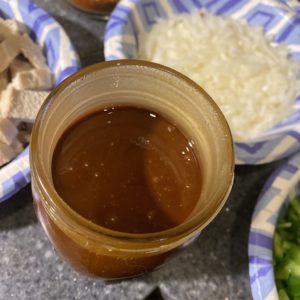 I did, however, finally manage to make a bit of roux that worked out beautifully in the end (though the picture makes it look like there’s all kinds of stuff in it, it’s a trick of the light/flash, I think, because it’s really smooth and consistent in “real life”). It came with the price tag of several hours of work and multiple attempts, but the end result was exactly the color I needed and it wasn’t the gritty texture that other batches devolved into after about ten minutes. Even now, three months later, it’s still workable—though it’s about time to let that go and make a new batch. With a new set of cast iron in the house, I’m ready to try again and see if cast iron makes the difference I hear it will.
I did, however, finally manage to make a bit of roux that worked out beautifully in the end (though the picture makes it look like there’s all kinds of stuff in it, it’s a trick of the light/flash, I think, because it’s really smooth and consistent in “real life”). It came with the price tag of several hours of work and multiple attempts, but the end result was exactly the color I needed and it wasn’t the gritty texture that other batches devolved into after about ten minutes. Even now, three months later, it’s still workable—though it’s about time to let that go and make a new batch. With a new set of cast iron in the house, I’m ready to try again and see if cast iron makes the difference I hear it will.
As to gumbo, well, there is no One True Way to make gumbo, but it always has that roux in common. However, after so much research I did learn that there are two basic types of gumbo: cajun and creole, and the only major difference between them is the inclusion of tomatoes. Certainly there are other differences in various spices depending on who’s momma did what and what year after the Civil War and nonsense like that—cajun seems to work with “fewer and hotter” spices than creole as well—but it appears that tomatoes really is the only major difference in the two styles when it comes down to the final analysis and that was a matter of … *drum roll please* … money and privilege.
The Key to Success: Making the Roux
First, to make a roux is tricky. I’m just going to admit that up front. Anyone that tells you that it takes 10 minutes at some kind of nuclear-level heat is lying to you. They just are. Full stop. In no real cooking world does that actually happen (outside some chef that popularized the technique in a book because he was too lazy to do it right—and admitted that was the reason). To make a proper cajun roux takes a minimum of an hour. It’s a slow and painful process. It’s so slow and painful, in fact, that I’m just going to offer you a link to a video that gives a good breakdown of how to make a good roux and then provide someone else’s recipe for roux that works out beautifully if you follow the directions precisely. Trust me. It really does.
Here’s the video: First You Make A Roux
And here is an “instruction only” version of the recipe itself (I’ve taken this from here):
ROX’S ROUX (DARK CAJUN ROUX)
A Cajun roux starts out in a large cast iron pot over medium heat. With no distractions and approximately one hour of time at your disposal, begin by adding [equal amounts of] flour and oil. [The recipe calls for 3 cups of each, and I’ve found it takes a bit more than an hour but that may just be me.]
With a long-handled wooden spoon, begin to stir. Constant stirring and moving the flour around the bottom of the pot is the key to browning the flour evenly to prevent burning. This early stage will go slowly as you begin to see the white flour take on a beige and then a tan color.
Continue stirring slowly and evenly, scraping the bottom and the circular crevices of the pot to move the flour around in the hot oil.
At about the half-hour mark, you will begin to see a brown color developing and smell the first hints of toasted flour. This is where the stirring becomes even more crucial.
At this point, you begin to enter the quickly developing phase where the least bit of inattention could result in burnt flecks of flour appearing – a sure sign you’ve ruined the roux. Watch your heat and lower it if the roux is cooking too fast.
Constant stirring to keep the flour from staying in one place too long prevents burning. You will begin to smell an even nuttier aroma as you see the color turn darker mahogany. Most stop here, but you will keep going until you achieve a deeper, darker chocolatey consistency and color.
Forget time at this point since you are now cooking by instinct, sight and smell. The utmost attention is needed to your stirring, and when you see that Hershey chocolate darkness, you will know you have arrived.
Turn off the heat, but continue stirring until it begins to cool down and quits cooking.
Spoon the roux into a bowl and let cool.
All I can tell you is that if you follow her directions, you’ll have success. Maybe not the first time, or the second, or the third, but eventually it will happen. It does work out and the results are entirely worth it.
Then, The Recipe Itself
Here’s the recipe that I’ve come up with. Because I despise okra, this recipe does without. I realize that gumbo is supposed to have okra in it and if that’s your thing, it’s quite easy enough to add it back in. Go for it. You can substitute okra for the filé—or use both, though I would recommend starting out with half the amount of filé at first if you use the okra.
2 pounds boneless skinless chicken, ½ inch cut (breasts and thighs work best)
1 package of Andouille sausage, cooked, sliced
1 package of medium sized shrimp
1½ cups yellow onion, diced
1½ cups bell pepper, green, diced (if you want to throw in other colors, have at it)
⅓ cup celery
4 cloves garlic, minced
1 can of canned diced tomatoes, (14.5 ounces)
Creole-Cajun spice mix [see below]
1 Tablespoon gumbo filé
Technically, the inclusion of tomatoes in this recipe makes this a “creole” dish. I haven’t tried it yet without tomatoes because it’s just fine with them. I honestly think it gives the whole thing body and flavor that would be missing without them. But I guess you could forgo them and see what happens. You may need a little extra water in that case, maybe a cup or two.
The Spice Mix
I make my own Creole-Cajun spice mix. I found a several mixes on the internet and have played with them over the months that I’ve been working with this recipe. I keep tweaking it until it’s the way I like it. For the most part, however, I’ve left it in the proportions that I found it, but with the tweaks that I’ve made. When I use it, I double it. That’s just my tastes. Use your own judgement when making this dish.
2 teaspoons smoked paprika
1½ teaspoons garlic powder
¾ teaspoon black pepper
¾ teaspoon cayenne pepper (or more/less based on your own tastes, though I honestly don’t recommend more)
¾ teaspoon onion powder
½ teaspoon dried oregano
½ teaspoon dried thyme
⅛ teaspoon (or less) celery seed — a dash will work or leave it out altogether if you don’t have it
If you don’t have all that and just have some cajun spice laying around, then I would go with 2-3 Tablespoons of spice into the whole thing. I don’t throw any salt into it but wait until it’s all done and salt to taste or, depending on the crowd being served, let them salt it to their own tastes.
Finally, How to Put It All Together
In a medium-sized pot, add chicken and cover with water. Bring water to a boil, then simmer until fully cooked about 20 to 25 minutes. Strain water and reserve. Sometimes I will use half water and half chicken broth to give more flavor. I think this actually works a bit better in the long run. Just a tip there.
Remove chicken from pot and shred into small pieces, set aside for later. Shredding the chicken is important. I cut chicken into chunks so much for other recipes, but for this you have to shred. Otherwise, it’s just too bulky.
Make roux. [See recipe above—or, use the roux that you’ve already made, ideally. If you’ve previously made roux and stored it, then you’ll pour enough roux to cover the bottom of your pan. Be careful, though, in that you can certainly burn your roux at this point. It’s already at the stage that you want it. Applying high heat all of a sudden can throw it over the top into a burned stage and ruin that roux again. Heat it up, certainly, and get it hot enough to cook; then go on to the next steps in the recipe quickly.]
 Add onion, bell peppers, celery—the holy trinity of cajun cooking. Sauté until vegetables are tender, about 8 to 10 minutes. (I have never found that it takes that long to cook all this, but so many websites and recipe books claim that it does. Maybe it’s my gas stove just cooks hotter? You do what’s best for you, but make sure it’s all cooked and tender; that’s the important part here.) Then add garlic and let that cook for a minute or so as well.
Add onion, bell peppers, celery—the holy trinity of cajun cooking. Sauté until vegetables are tender, about 8 to 10 minutes. (I have never found that it takes that long to cook all this, but so many websites and recipe books claim that it does. Maybe it’s my gas stove just cooks hotter? You do what’s best for you, but make sure it’s all cooked and tender; that’s the important part here.) Then add garlic and let that cook for a minute or so as well.
Add tomatoes and sliced Andouille sausage. Cook for 10 minutes, stirring occasionally.
Add spice mix and 4 cups of the reserved water. Mix all that up well. You may add more water. It will depend on how thick you want your gumbo.
Loosely cover the pot and simmer over medium-low heat for about 30 minutes, stirring occasionally.
Add cooked shredded chicken and simmer about 15 minutes longer. Then add shrimp and cook for about 3 to 4 minutes.
Turn off heat, and slowly stir in the gumbo filé. Taste and season with salt and pepper as desired.
Serve with a tower of steamed rice (about ½ to ¾ cup of rice to about 2 cups of gumbo is what I find to be the perfect ratio) and a torn baguette.
Enjoy!
